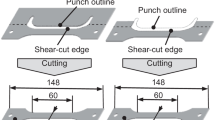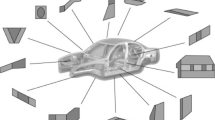Abstract
Blanking of sheet metal is an important forming process in the automotive industry for the manufacture of mechanical components. The final component shape, obtained at the end of bending or deep-drawing processes, often has sharp edges due to the blanking operation. Concerning passenger safety components, like seat belt anchors, rounding of the edges by punching is necessary to avoid cutting the belt material. In addition to removing the sharp edges, the punching results in work hardening of the material in the rounded zones which results in an increase in the local resistance of the material. In this study, a high-strength low-alloy steel (HSLA S500MC) has been tested with the aim of quantifying the blanking and edge rounding operations. The mechanical behaviour of test specimens is investigated by means of tensile tests and the material is characterised in terms of Vickers micro-hardness. Numerical simulations of the edge rounding process are developed using previously identified material behaviour laws. The residual stress fields are characterised and compared to experimental results. This is done so that numerical simulation can be done in the future to prediction the in-service behaviour of the component. Specimens with rounded edges are compared to specimens that were not submitted to the rounding operation. It is shown that Edge Rounding by Punching improves the component resistance, therefore justifying the use of this process in the manufacture of automotive safety components.
Similar content being viewed by others
References
Sacks J, Welch WJ, Mitchell TJ, Wynn HP (1989) Design and analysis of computer experiments. Stat Sci 4:409–435
Welch WJ, Yu TK, Kang SM, Sacks J (1990) Computer experiments for quality control by parameter design. J Qual Technol 22:15–22
Gosh A, Popat PB, Raghu V (1985) A new approach to the mechanics of the blanking operation. Theoretical model and experimental verification. J Mech Work Technol 11:215–228
Maillard A (1991) Experimental and theoretical study of blanking. PhD Thesis. University of Technology of Compiègne
Klingerberg W, Singh UP (2003) Finite element formulation of the punching blanking process using in-process characterisation of mild steel. J Mater Process Technol 134:296–302
Thipprakmas S, Jin M, Murakawa M (2007) Study on flanged shapes in fineblanked-hole flanging process (FB-hole flanging process) using finite element method (FEM). J Mater Process Technol 192–193:128–133
Hambli R, Potiron A (2000) Finite element modelling of sheet-metal blanking operation with experimental verification. J Mater Process Technol 102:257–265
Shim KH, Lee SK, Kang BS, Hwang SM (2004) Investigation on blanking of thin sheet metal using the ductile fracture criterion and its experimental verification. J Mater Process Technol 155–156:1935–1942
Kim SS, Han CS, Lee YS (2005) Development of a new burr-free hydro-mechanical punching. J Mater Process Technol 162–163:524–529
Marciniak Z, Duncan J (1992) Mechanics of sheet-metal forming. First published E. Arnold, London
Livatyali H, Altan T (2001) Prediction and elimination of springback in straight flanging using computer aided design methods. Part 1 experimental investigations. J Mater Process Technol 117:262–268
Livatyali H, Wu HC, Altan T (2002) Prediction and elimination of springback in straight flanging using computer aided design methods. Part 2 FEM predictions and tool design. J Mater Process Technol 120:348–354
Mkaddem A, Potiron A, Lebrun JL (2002) Straightening and bending process characterization using Vickers micro hardness technique, Proceeding of International Conference of Advanced Technology of Plasticity, Tokyo, Japan, Oct. 27–Nov.1, 2002, Proceedings Institute of Industrial science, The University of, Komaba, 631-636
Hambli R (1996) Theoretical, numerical and experimental study of sheet-metal blanking operation in view of the process optimization. PhD Thesis. ENSAM Angers
Hambli R, Guérin P (2003) Application of neural networks for optimum clearance prediction in sheet-metal blanking process. Finite Elem Anal Des 39:1039–1052
Lemaître J, Chaboche JL (2004) Mécanique des Matériaux Solides. Dunod
Mkaddem A, Gassara F, Hambli R (2006) A new procedure using the microhardness technique for sheet material damage characterisation. J Mater Process Technol 178:111–118
Lemaître J, Dufailly J, Billardon R (1987) Evolution of damage by microhardness measuring. Comptes Rendus de l’Académie des Sciences, 601-604
Mkaddem A, Bahloul R, Dal-Santo P, Potiron A (2006) Experimental characterisation in sheet forming processes by using Vickers micro hardness technique. J Mater Process Technol 180:1–8
Hauk V (1997) Structural and residual stress analysis by non-destructive methods. Elsevier, Amsterdam
Abaqus (2009) Analysis user’s manual (Version 6.9)
Achouri M, Germain G, Dal Santo P, Saidane D (2013) Experimental characterization and numerical modeling of micromechanical damage under different stress states. Mater Des 50:207–222
Martins JA, Cardoso LP, Fraymann JA, Button ST (2006) Analyses of residual stresses on stamped valves by X-ray diffraction and finite elements method. J Mater Process Technol 179:30–35
Author information
Authors and Affiliations
Corresponding author
Rights and permissions
About this article
Cite this article
Achouri, M., Gildemyn, E., Germain, G. et al. Influence of the edge rounding process on the behaviour of blanked parts: numerical predictions with experimental correlation. Int J Adv Manuf Technol 71, 1019–1032 (2014). https://doi.org/10.1007/s00170-013-5522-8
Received:
Accepted:
Published:
Issue Date:
DOI: https://doi.org/10.1007/s00170-013-5522-8




